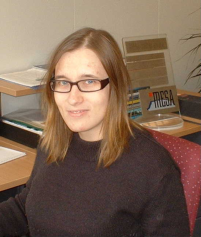Bridging length and time scales by AFM-based nanotribology: Applications to nanostructured ceramics and polymer surfaces.
Promotion date: 27 April 2006
| Tribology is a study of friction, adhesion, lubrication and wear of surfaces in relative motion. I focused on friction on the nanoscale. With Atomic Force Microscopy you can measure different types of forces. In the AFM contact mode a sharp tip is attached to a flexible cantilever and brought into contact with the surface. Scanning the forces between atoms of the AFM tip and atoms of the sample surface will result in deflection of the cantilever. The torsion of the cantilever is proportional to the friction force between the tip and the surface. |
What was your thesis about?
Tribology is a study of friction, adhesion, lubrication and wear of surfaces in relative motion. I focused on friction on the nanoscale. With Atomic Force Microscopy you can measure different types of forces. In the AFM contact mode a sharp tip is attached to a flexible cantilever and brought into contact with the surface. Scanning the forces between atoms of the AFM tip and atoms of the sample surface will result in deflection of the cantilever.
The torsion of the cantilever is proportional to the friction force between the tip and the surface. However, the velocity range accessible with conventional AFMs is limited. I developed a high velocity accessory for a commercial AFM in order to be able to work in the same velocity range on the micrometer scale and the nanometer scale tribology to compare the phenomena.
But why is there a friction between the AFM tip and the surface?
You don’t touch the surface.
You do touch the surface. It is with STM (Scanning Tunnelling Microscopy) that you don’t.
AFM is like a gramophone; you put a tip over a surface. At the same time, you can obtain surface topography and measure the friction forces acting on the tip.
Why would you want to measure friction?
There is a long history why people try to measure friction and try to understand why there is wear, how to control friction. There are a lot of problems connected with joints because of high friction. In nanostructures we want to understand the friction of materials in order to control it. We want to be able to design structures with either high or low friction.
Measuring friction force with AFM started more than 10 years ago. But the difficulty of calibrating the cantilever remained. Many of the existing techniques to calibrate the friction forces suffer from large errors and poor reproducibility.
We wanted to have a universally applicable method that provides a precise calibration of all types of AFM cantilevers and tips. We designed and fabricated a new calibration standard for quantitative friction force analysis.
So your thesis is very important for your colleagues working with AFM?
Yes, for those who want to do quantitative friction measurements. I got three publications in relatively important journals and another two to come.
Where are you from?
I am from Poland. When I finished my studies in Poland I wanted to go abroad and get some more experience. I had the change to come here in the Socrates exchange programme. I came to the group of Professor Vancso working with the AFM and then I got a proposition to come again and do a PhD.
What did you like best about your research?
When I started the project is was all completely new for me. It was a continuous discovery of novel things in the field of nanotribology. It was definitely a challenge, because also in the group I was the first one working on this. So I did not have much feedback.
Also in doing a PhD in a foreign country you learn to become very independent, living without your family and friends. And I also had the opportunity to attend a fantastic conference on nanotribology in India in the Himalaya area, close to Tibet and Nepal. After the week’s conference I have been travelling in India for another two weeks.
Are you going to continue in the field of nanotechnology?
It depends. I still like learning new things. Right now I started a different project, also in Professor Vancso’s group. It is related to AFM again, functionalizing the probes with different molecules (e.g. hydrophilic or hydrophobic).
The project is carried out in collaboration with Smart Tip. (A Mesa+ spin off company).

